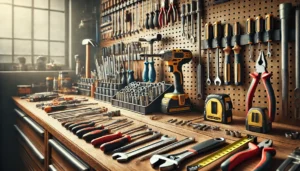Piping systems in the industrial sectors often employ flange joints as structural components for the adequate and secure transfer of fluids and gases. A gasket, in simple terms, is a narrow thin strip that’s situated between the two faces of a bolt and a nut. Gasket selection is crucial because it helps to halt any leakages, security concerns, or other operational difficulties, optimizing circumstance.
This blog post discusses the factors that need to be considered when selecting a gasket and factors, making suggestions that can help performance within the system as a whole.
Gaskets on Flange Joints
As sealing material, gaskets are designed to fill the gaps between two flanges, overcoming manufacturing and installation discrepancies. Gaskets help the joints to withstand the highest operational temperatures and pressures of the fluid at use The correct gasket choice will seal tightly to prevent any leakage in the joint, even when subjected to thermal expansion, vibrations and pressure variations.
A correct gasket is crucial because, without the right one, the danger of having leaks or any type of joint failure becomes imminent – which would be dangerous considering the amount of money that would be spent reconstructing everything again.
Why the Selection of Gasket material is an Important Consideration
Leakage Prevention
Sealing turns out to be among the major roles of a gasket. If a gasket does not meet the requirements of the job, it suffers stress and subsequently leaks fluid or gas. This is a major reason for concern, particularly in systems that move dangerous substances. However, gaskets that are properly matched to the application are hard to leak, even during the most demanding application scenarios.
Avoiding Risks
The critical problems that a available leak in a flange joint can cause such an explosion inside a stock zone, harming people’s health with poisonous gasses, or harming the environment among others. Take for instance a bad gasking of a tap for a high pressure gasing pipeline. The consequences could be disastrous. These types of accidents can be avoided through a proper selection of gasket material and shape design.
Reducing Unscheduled Downtime and System Improvement.
The unscheduled shutdown of gaskets is quite common and many times stretches productivity and the monetary resources of a firm. A sound gasket enables a reduction in maintenance practices resulting into maximum possible run time of the systems. Also, it in many cases, results into the steady pressure and flow rate of the system.
Increasing the Lifetime of Equipment
An incorrect gasket may be the reason behind the failure of the flange by overstressing it or by leaking. Flange surfaces are prone to damage over time in the form of corrosion, wear and deformation. It is clear, that by using a suitable gasket, the stresses acting on the flange joint are minimized and as a result, the joints and equipment are safeguarded allowing the appliance to last longer.
Considerations When Turning to the Application of Gaskets
System Specifications
Maximum allowable thickness, elasticity, expansion rate and compatibility with uncontrolled temperatures and pressure of the fluid must be taken into consideration. Spiral wound gaskets are very good in regards to steam lines with high temperature. While, for PTFE it is relatively soft and for the application of gaskets exposing chlorine and to be corrosive it is the suitable choice for usage.
Compression Area and Classification of Flanges
The type of flange shown in the picture (raised face, flat face or ring-type joint) determines the thickness and material of the gasket employed. For instance, Spiral wound gaskets are typically installed on raised face flanges while Flat face flanges are best with flat gaskets.
Material Deterioration
Technician need first to ensure the type of the chemical present as certain types of chemicals require specific types gaskets that are chemically resistant. As an example, their PTFE (Teflon) gaskets are excellent for treatment with various solvents, acids, and alkalis and are used in those industries where chemical processing is regularly done.
Temperature and Pressure Ratings
The Gasket material should tolerate the system’s highest working temperatures and pressure. For high transverse hydraulic loadings ring-type joint (RTJ) gaskets can be used as metallic gaskets, but for low transverse hydraulic loading rubber or elastomers can be used.
Industry Standards
Standards such as ASME, API or EN specify requirements that enable the gasket to be safe and perform well. Such standards also set principles of design regarding gasket thickness, material types, and methods of testing making works of the engineers less guess works.
Types of Gaskets
Non-Metallic Gaskets
Non-metallic, such as flexible rubber, PTFE or graphite gaskets, works best for below medium pressure services. These gaskets are used in pipelines, chemical units, hvac systems and many others.
Metallic Gaskets
Metallic gaskets, such as RTJ gaskets or corrugated metal gaskets are preferred in high pressures and high temperatures conditions. They are very firm and withstand extreme conditions in most gas and oil pipelines or steam system.
Semi-Metallic Gaskets
Semi-metallic gaskets like spiral wound gaskets incorporate the best features of both non-metal and metal material, thus they are quite common because of their adaptability to various pressures. These gaskets, for example gasket petrole gasses, are widely used in the petrochemical, power generation and refinery.
Common Mistakes in Gasket Selection
Disregarding Operating Conditions: Selecting a gasket without paying attention to any of the temperature, amount of pressure or the properties of fluids that would be used would ensure that it will get destroyed quickly.
Selecting the Wrong Material: Using materials that are not compatible with one another can lead to chemical deterioration or leaking.
Using Wrong Procedures: Even using the right gasket could prove futile, as it has to be installed properly, as leaking may occur when uneven torque is applied or misalignment occurs preventing the gasket from sealing.
Disregarding Regulations: Safety and performance may be at risk when universal rules are not followed.
The Cost of Choosing the Wrong Gasket
Gaskets play a critical role making sure the seals remain intact. Not only will an unsuccessful gasket be expensive but it will also be a huge operational headache. For instance, in areas such as oil refinery plants and chemical plants the use of gaskets is crucial because the slightest failure could cause great losses not only to the company itself but also to stakeholders. Hence, it is impotent to invest in sturdy gaskets since they provide insulation while also allowing cost savings.
Conclusion
Choosing the right gasket to use is fundamental while maintaining or designing a piping system. A properly chosen gasket prevents leakage while ensuring that overall operational efficiency is maintained while also enhancing safety. Through applying specific conditions the right selection can be made which optimally supports the functions desired.
In industrial functioning where risks are at the peak, good gaskets must be a requirement. It is mostly protection against possible failures or risks. When one has made the right selection at the beginning it can save costs and risks while also ensuring security for a long period of time.










